
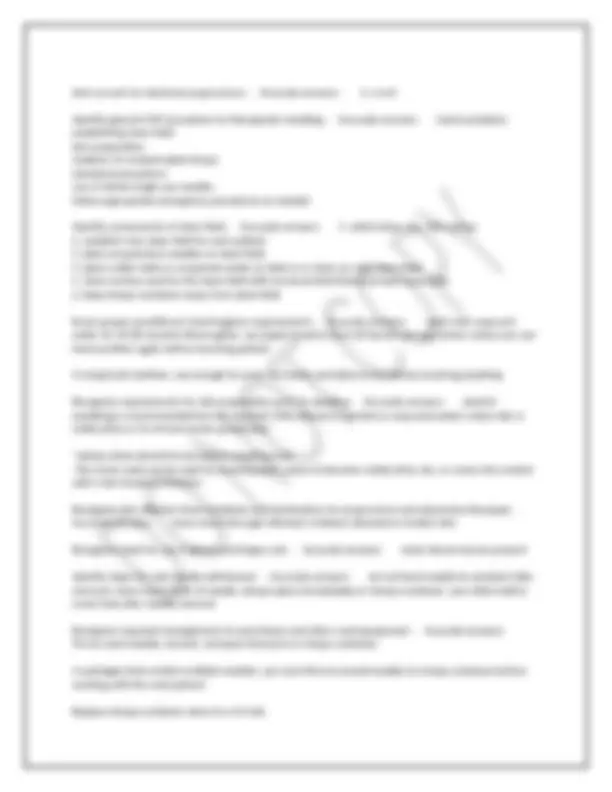
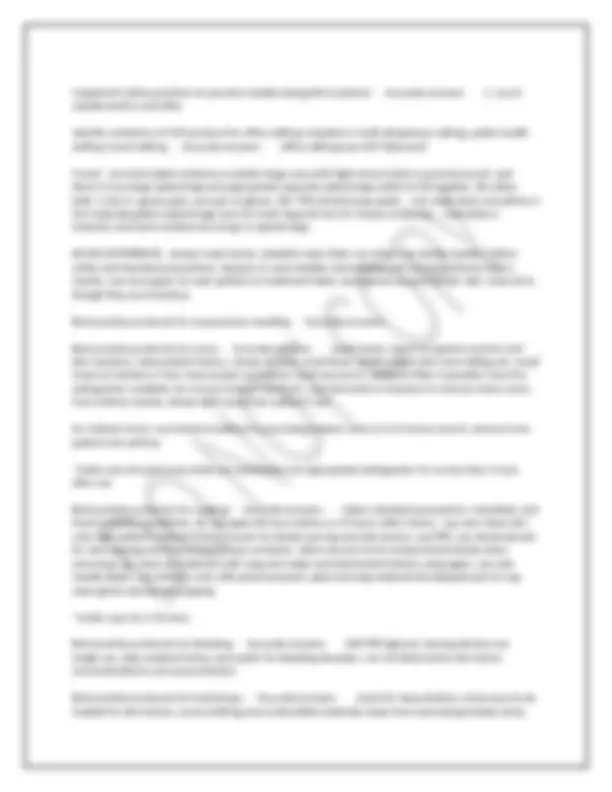
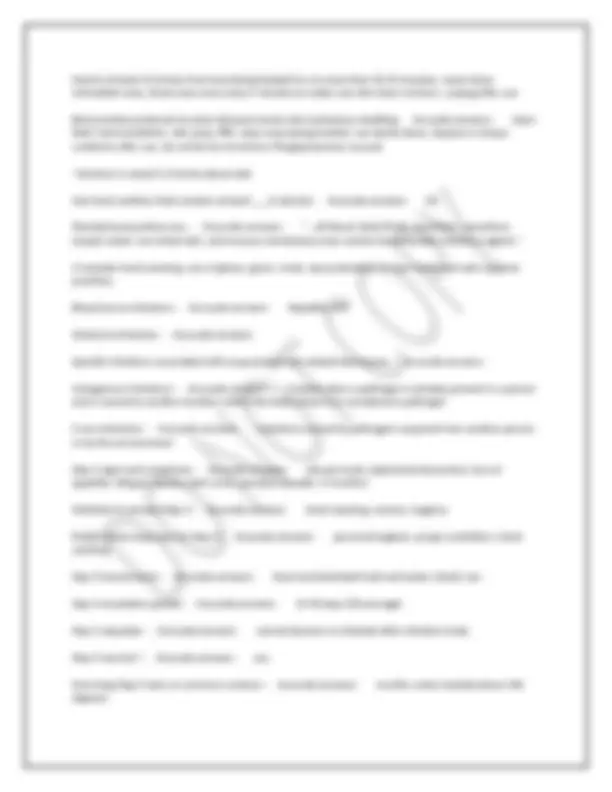
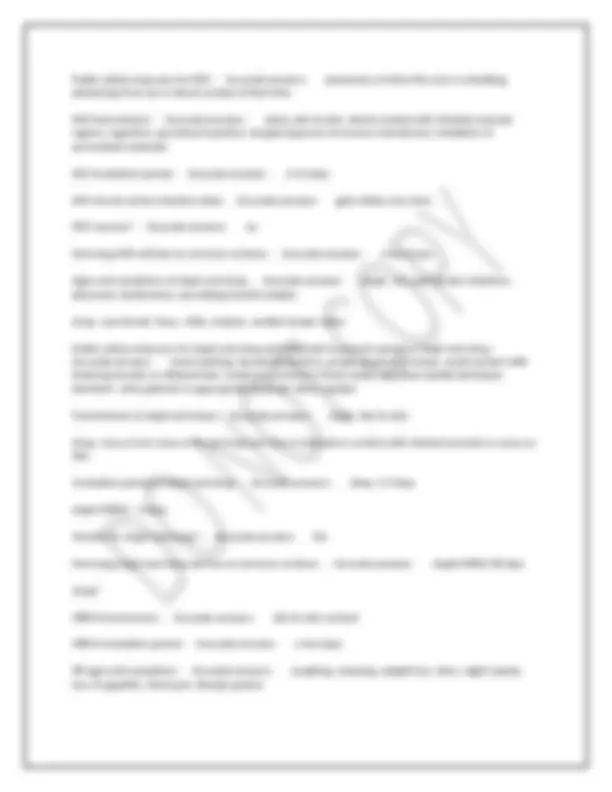
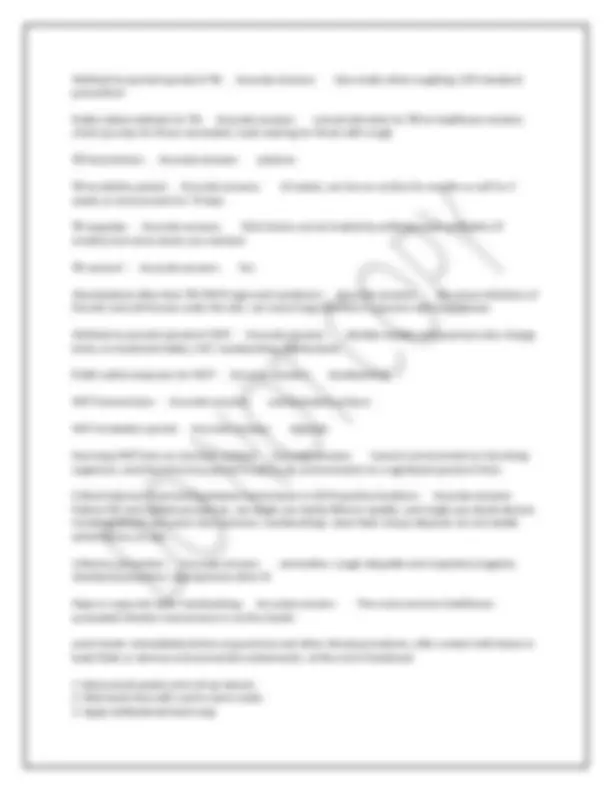
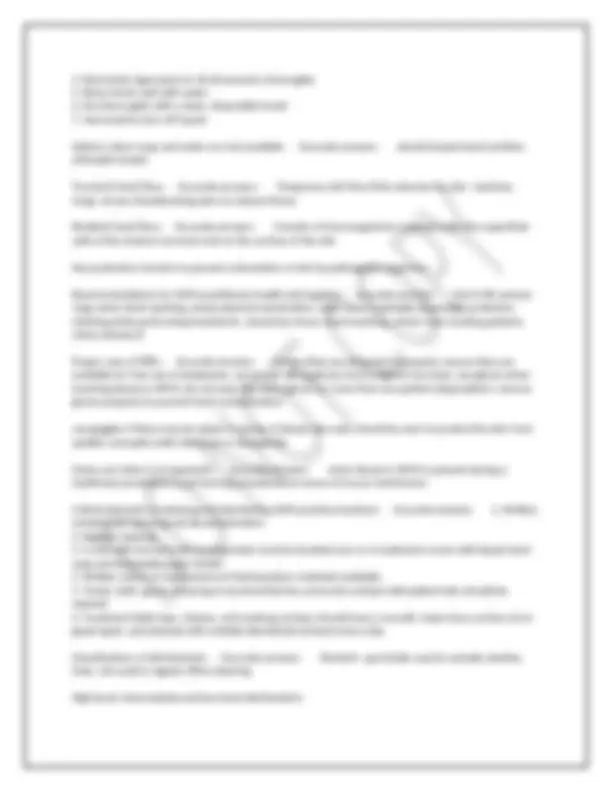
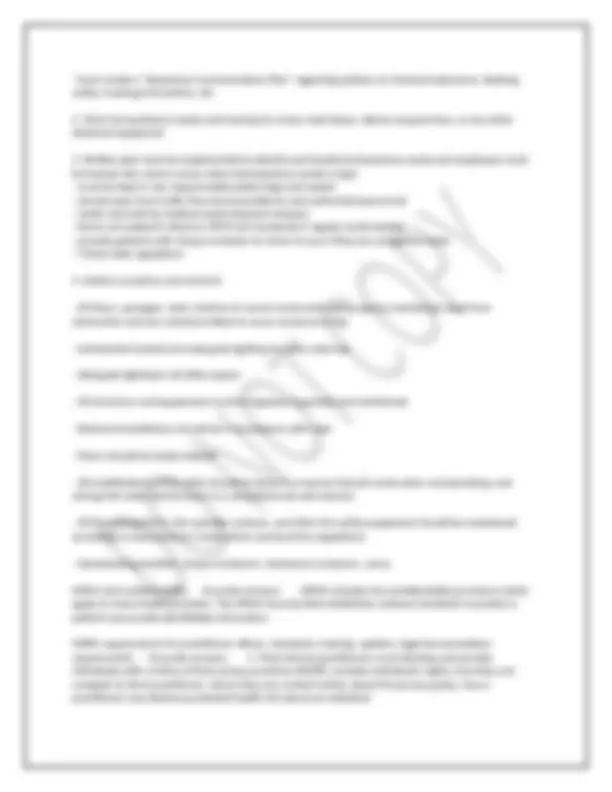
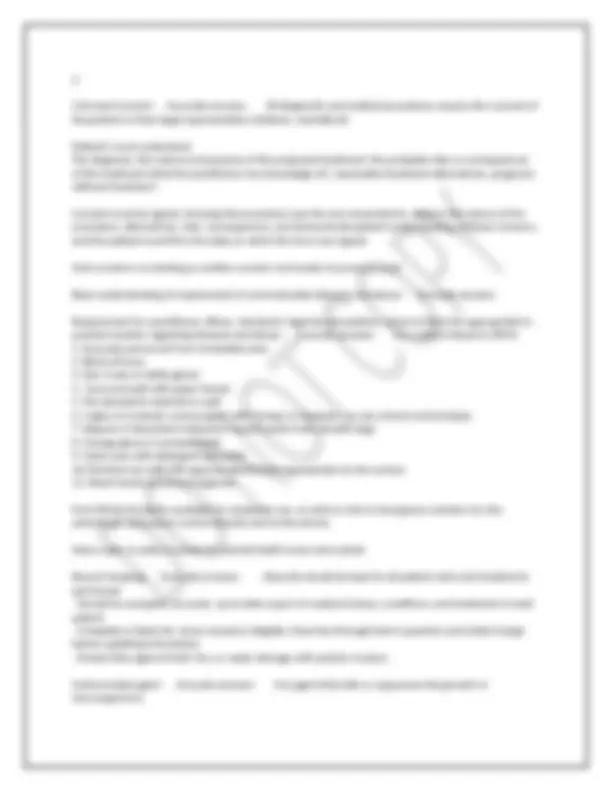
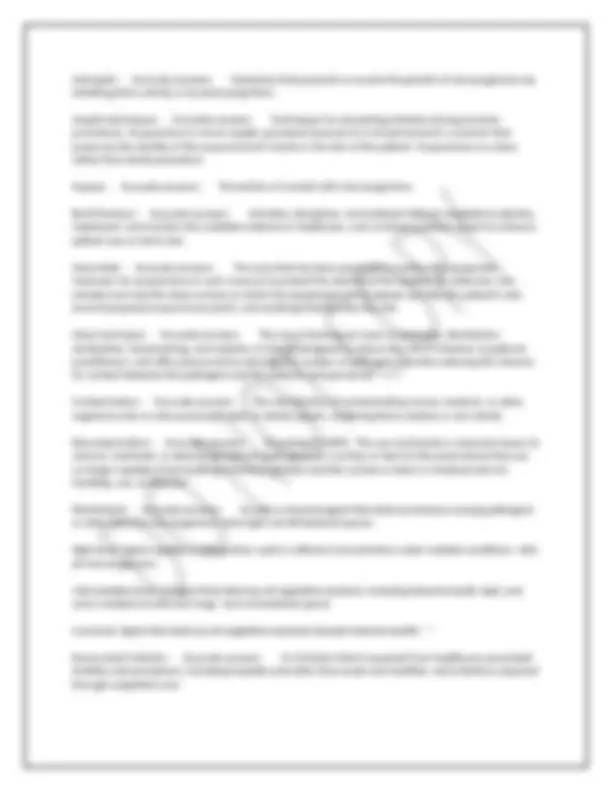


Study with the several resources on Docsity

Earn points by helping other students or get them with a premium plan


Prepare for your exams
Study with the several resources on Docsity

Earn points to download
Earn points by helping other students or get them with a premium plan
Community
Ask the community for help and clear up your study doubts
Discover the best universities in your country according to Docsity users
Free resources
Download our free guides on studying techniques, anxiety management strategies, and thesis advice from Docsity tutors
CNT TEST QUESTIONS WITH 100% ACCURATE ANSWERS
Typology: Exams
1 / 16

This page cannot be seen from the preview
Don't miss anything!










AE (adverse effects) of acupuncture - Accurate answers site bleeding, superficial hematoma, needle site pain less frequently: fainting, tiredness, aggravation, broken needle rare but serious (SAEs): pneumothorax, injury to organs, traumatic tissue injury Critical and recommended procedures to reduce risks and AE of acupuncture - Accurate answers 1. be aware of vascular anatomy
Implement safety practices to prevent needles being left in patient - Accurate answers 1. count needles before and after Identify variations of CNT protocol for office setting, hospital or multi-disciplinary setting, public health setting, travel setting - Accurate answers office setting (see CNT flashcard) Travel - use hard-sided container or plastic large case with tight closure that is puncture proof, seal items in one large ziplock bag and appropriate separate ziplock bags within it (20 needles, 20 cotton balls, 5 2x2 in. gauze pads, one pair of gloves, 30+ 70% alcohol prep pads)... non-clean items should be in two separate gallon ziplock bags (one for trash bag and one for sharps container)... hemostat or tweezers and hand sanitizer do not go in ziplock bags NO BIG DIFFERENCE - always wash hands, establish clean field, use single-use sterile needles, follow safety and standard precautions, dispose of used needles immediately into sharps container that is nearby, use new paper for each patient on treatment table, wear gloves around broken skin, treat all as though they are infectious Best practice protocols for acupuncture needling - Accurate answers Best practice protocols for moxa - Accurate answers wash hands, check for patient comfort and skin reactions, take patient history, remain in room at all times, shield patient skin from falling ash, avoid moxa on hairline or face, have proper ventilation, chart any burns, utilize air filter if possible, have fire extinguisher available, do not put moxa in trashcan!, use hemostat or tweezers to remove moxa cones, have ashtray nearby, always light away from patient's skin for indirect moxa, use herbal insulation to area being heated, when 2/3 of moxa is burnt, remove from patient into ashtray *make sure all used moxa sticks are contained in an appropriate extinguisher for no less than 1 hour after use Best practice protocols for cupping - Accurate answers follow standard precautions, cleanfield, and hand sanitation guidelines, do not apply 48 hours before or 24 hours after chemo., cup over clean skin only, take patient medical history, screen for keloid scarring and skin lesions, use PPE, use sterile lancets for wet cupping and discard into sharps container, allow vacuum to be compromised slowly when removing cup, clean all materials with soap and water and disinfectant before using again, use safe needle depth, cup children only with parent present, place burning material into deepest part of cup, wear gloves during wet cupping *retain cups for 2-10 mins Best practice protocols for bleeding - Accurate answers USE PPE (gloves), lancing devices are single-use, take medical history and watch for bleeding disorders, do not bleed active skin lesion, recommended to use eye protection Best practice protocols for heat lamps - Accurate answers check for lamp defects, check area to be treated for skin lesions, move clothing and combustible materials away from area being heated, lamp
head is at least 12 inches from area being heated for no more than 10-15 minutes, never leave immediate area, check area once every 5 minutes to make sure skin does not burn, unplug after use Best practice protocols for plum blossom/seven-star/cutaneous needling - Accurate answers clean field, hand sanitation, skin prep, PPE, clean area being treated, use sterile items, dispose in sharps container after use, do not be too forceful or flinging hammer around *hammer is raised 1-2 inches above skin Use hand sanitizer that contains at least ___% alcohol - Accurate answers 60 Standard precautions are: - Accurate answers "...all blood, body fluids, secretions, excretions except sweat, non-intact skin, and mucous membranes may contain transmissible infectious agents." It includes hand washing, use of gloves, gown, mask, eye protection, or face shield and safe injection practices. Blood borne infections - Accurate answers Hepatitis, HIV Airborne infections - Accurate answers Specific infections associated with acupuncture and related techniques - Accurate answers Autogenous infections - Accurate answers Created when a pathogen is already present in a person and is moved to another location within the body where it is considered a pathogen Cross infections - Accurate answers Infections caused by pathogens acquired from another person or by the environment Hep A signs and symptoms - Accurate answers abrupt onset; abdominal discomfort, loss of appetite, fatigue, nausea, dark urine, jaundice (usually <2 months) Methods to prevent Hep A - Accurate answers hand-washing, vaccine, hygiene Public safety measures for Hep A - Accurate answers personal hygiene, proper sanitation, hand- washing Hep A transmission - Accurate answers fecal contaminated food and water, blood, sex Hep A incubation period - Accurate answers 15-50 days (28 average) Hep A sequelae - Accurate answers cannot become re-infected after infection heals Hep A vaccine? - Accurate answers yes How long Hep A lasts on common surfaces - Accurate answers months unless heated above 185 degrees
Hep D signs and symptoms - Accurate answers *Requires concurrent Hep B infection for development of disease severe hepatitis OR transform a mild or asymptomatic chronic HBV into a more severe disease process, causing increased scarring of the liver Methods to prevent spread of Hep D - Accurate answers Hep B vaccine, clean needle, safe sex Public safety measures for Hep D - Accurate answers Hep B vaccine Hep E signs and symptoms - Accurate answers *Rarely seen in US sudden onset of fever, malaise, nausea, anorexia, possible jaundice, can lead to death in pregnant women Methods to prevent spread of Hep E - Accurate answers don't drink contaminated drinking water, clean kitchen practices Public safety measures for Hep E - Accurate answers clean food and drinking water HIV signs and symptoms - Accurate answers (can be asymptomatic) fever, malaise, body aches, maculopapular rash, lymphadenopathy, headache, fever, night sweats, rapid/unexplained weight loss, chronic diarrhea, persistent cough, flat or raised pigmented lesions on the skin ranging in color from pink, red, brown or blue Methods to prevent spread of HIV - Accurate answers Standard precautions! (use barriers) Public safety measures for HIV - Accurate answers safe sex, safe needle use, safe healthcare practices HIV transmission - Accurate answers blood to blood contact, contaminated needles (drugs) HIV incubation period - Accurate answers 8-10 years , developing into AIDs for some HIV chronic active infection state - Accurate answers Chronic - can turn into AIDS and immunodeficiency diseases such as pneumocystitis carinii pneumonia (leading cause of death), Kaposi's sarcoma, esophageal candidiasis, cytomegalovirus. HIV vaccine? - Accurate answers no - protease inhibitors and other drugs to ease symptoms How long HIV lasts on common surfaces - Accurate answers dies within minutes Herpes simplex virus signs and symptoms - Accurate answers recurring legions, itching, pain, tingling at site of infection Methods to prevent HSV spreading - Accurate answers standard precautions, disinfect surfaces daily
Public safety measures for HSV - Accurate answers awareness of when the virus is shedding, abstaining from sex or direct contact at that time HSV transmission - Accurate answers saliva, skin to skin, direct contact with infected mucosal regions, ingestion, parenteral injection, droplet exposure of mucous membranes, inhalation of aerosolized materials HSV incubation period - Accurate answers 2-12 days HSV chronic active infection state - Accurate answers gets milder over time HSV vaccine? - Accurate answers no How long HSV will last on common surfaces - Accurate answers a few hours Signs and symptoms of staph and strep - Accurate answers staph: red, painful skin infections, abscesses, bacteremia, necrotizing fasciitis (staph) strep: sore throat, fever, chills, malaise, swollen lymph nodes Public safety measures for staph and strep and Methods to prevent spread of staph and strep - Accurate answers hand washing, barrier protections, proper disposal of sharps, avoid contact with draining wounds or inflamed skin, avoid acupuncture in those areas, use clean needle technique, disinfect!, refer patients to appropriate physician when needed Transmission of staph and strep - Accurate answers staph: skin to skin strep: mucus from nose or throat of person who is infected or contact with infected wounds or sores on skin Incubation period of staph and strep - Accurate answers strep: 1-4 days staph/MRSA: ~3 days Vaccine for staph and strep? - Accurate answers No How long staph and strep will live on common surfaces - Accurate answers staph/MRSA 90 days strep? MRSA transmission - Accurate answers skin to skin contact MRSA incubation period - Accurate answers a few days TB signs and symptoms - Accurate answers coughing, sneezing, weight loss, fever, night sweats, loss of appetite, chest pain, bloody sputum
Items: critical - enter vascular system or any sterile internal part of the body semi-critical - touch mucus membranes and non-intact skin non-critical - touch intact skin Commonly used disinfectants - Accurate answers chlorine and chlorine compounds, glutaraldehyde, hydrogen peroxide, idophors, phenol, Who approves use of disinfectants for healthcare offices and procedures? - Accurate answers Antimicrobials Division, Office of Pesticides Program, EPA Monitoring and labeling disinfectants - Accurate answers All disinfectants should be handled according to manufacturer's instructions and labeled if they are not in their original bottle (including the day it was mixed and its concentration) Identify steps for surface disinfection - Accurate answers Clean with soap and water first, soak in FDA-cleared disinfectant for time indicated for re-usable equipment Recognize instrument disinfection techniques - Accurate answers Cups used for wet cupping or gua sha spoons used on non-intact skin: wash, autoclave OR soak in high-level disinfectant Needles, 7 star hammers, lancets, press tacks, ear seeds - NOT reusable cups or gua sha spoons on intact skin require intermediate-level disinfectant BP cuff, stethoscope can be cleaned with soap and water and then low or intermediate disinfecting agent Best practices when dealing with blood/OPIM/bodily fluid spills - Accurate answers Use PPE appropriate for the area, wash area with soap and water first, disinfect contamination blood/OPIM spills using EPA-registered commercial hypochlorite solution and follow manufacturer's labels for spills and the amount of blood present, If the spill contains large amounts of blood, clean visible matter with disposable absorbent material and discard contaminated material in labeled biohazard waste container Needlestick protocol - Accurate answers wash needlestick location with soap and water, flush splashes to nose, mouth, or skin with water, irrigate eyes with clean water, saline, or sterile irrigants, seek medical advice by a liscenced physician as soon as possible Sharps disposal legal requirements and where to get state-specific info - Accurate answers 1. Labeled with biohazard symbol or be color-coded red.
*must create a "Hazardous Communication Plan" regarding policies on chemical exposures, labeling, safety, training information, etc.
Informed consent - Accurate answers All diagnostic and medical procedures require the consent of the patient or their legal representative (children, mentally ill) Patient's must understand: The diagnosis, the nature and purpose of the proposed treatment, the probable risks or consequences of the treatment (that the practitioner has knowledge of), reasonable treatment alternatives, prognosis without treatment Consent must be signed, showing the procedure was the one consented to, address the nature of the procedure, alternatives, risks, consequences, and demonstrate patient understanding of these concerns, and the patient must fill in the date on which the form was signed. Oral consent is as binding as written consent, but harder to prove in court. Basic understanding of requirement of communicable diseases and abuse - Accurate answers Requirement for practitioner offices, standards, legal documentation, where to find info appropriate to practice location regarding diseases and abuse - Accurate answers For a spill of blood or OPIM:
OPIM - Accurate answers Other potentially infectious material - all body fluids where it may be difficult to differentiate between contaminated and non-contaminated fluids Personal Protective equipment (PPE) - Accurate answers Specialized clothing or equipment worn by an employee for protection against a hazard. General work clothes not intended to function as protection against a hazard are not considered PPE. Sanitizer - Accurate answers Agent that reduces the number of bacterial contaminants to safe levels as judged by public health requirements, that is commonly used with substances applied to inanimate objects. According to the protocol for the official sanitizer test, a sanitizer is a chemical that kills 99.999% of the specific test bacteria in 30 seconds under the conditions of the test Standard Practice - Accurate answers Often synonymous with "customary practice." It is the legal term that is commonly defined as what a minimally competent healthcare provider in the same field would do in the same situation, with the same resources. Standard Precautions - Accurate answers A set of basic infection prevention practices intended to prevent transmission of infectious diseases from one person to another. Sterilization - Accurate answers A validated process used to render a product free of all forms of viable microorganisms. In a sterilization process, the presence of microorganisms on any individual item can be expressed in terms of probability. Although this probability can be reduced to a very low number, it can never be reduced to zero.